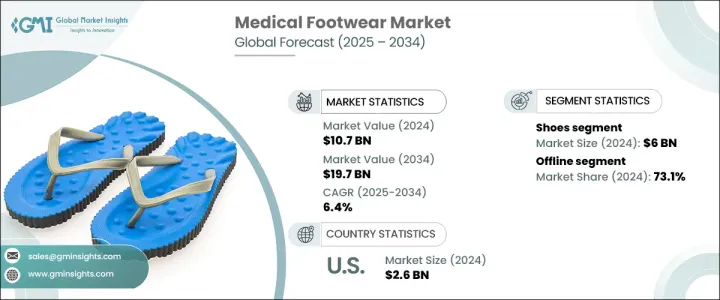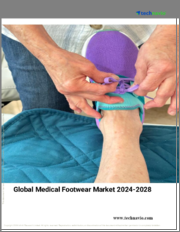
|
시장보고서
상품코드
1684652
의료용 신발 시장 : 기회, 성장 촉진요인, 산업 동향 분석(2025-2034년)Medical Footwear Market Opportunity, Growth Drivers, Industry Trend Analysis, and Forecast 2025 - 2034 |
||||||
세계의 의료용 신발 시장은 2024년에는 107억 달러로 평가되었고, 2025년부터 2034년까지 연평균 성장률(CAGR) 6.4%로 성장할 것으로 예측됩니다. 이러한 시장 성장은 족저근막염, 건막류, 당뇨병성 족부 궤양과 같은 발 관련 질환의 발병률 증가로 인해 특수 신발에 대한 수요가 급증하고 있기 때문일 수 있습니다. 고통스러운 발 질환을 완화하고자 하는 사람들이 늘어나면서 의료용 신발은 일상 생활의 필수품이 되었습니다.

이러한 기술 혁신은 신발의 편안함과 내구성을 향상시킬 뿐만 아니라 지속 가능한 고성능 제품에 대한 소비자 수요 증가에 부응하고 있습니다. 또한 전자상거래 플랫폼의 부상으로 의료용 신발에 대한 접근성이 높아지면서 소비자는 자신의 특정 요구에 맞는 제품을 온라인으로 쇼핑할 수 있게 되었습니다. 특히 만성 질환을 예방하기 위해 추가적인 지지력과 보호 기능을 제공하는 신발을 찾는 사람들이 늘어나면서 발 건강과 예방 관리의 중요성에 대한 인식이 높아지면서 시장이 더욱 성장하고 있습니다.
| 시장 규모 | |
|---|---|
| 시작 연도 | 2024년 |
| 예측 연도 | 2025-2034년 |
| 시작 금액 | 107억 달러 |
| 예측 금액 | 197억 달러 |
| CAGR | 6.4% |
의료용 신발 시장은 신발, 샌들, 기타 신발 등 다양한 제품 유형으로 세분화됩니다. 신발 부문에서만 2024년 60억 달러의 가치가 있었습니다. 발 건강이 전반적인 웰빙의 중요한 요소가 되면서 소비자들은 최적의 쿠션, 아치 지지력, 보호 기능을 제공하는 신발을 선호하고 있습니다. 예방과 편안함에 대한 강조가 커지면서 통증을 완화하고 발 건강을 지원하도록 특별히 설계된 신발에 대한 수요가 더욱 증폭되고 있습니다.
유통 채널의 경우, 의료용 신발 시장은 온라인과 오프라인 판매로 나뉩니다. 2024년에는 오프라인 부문이 73.1%의 압도적인 시장 점유율을 차지했습니다. 오프라인 소매점은 의료용 신발 구매 시 중요한 요소인 적절한 착용감과 편안함을 위해 고객이 신발을 신어볼 수 있는 개인화된 쇼핑 경험을 제공하기 때문에 의료용 신발 부문에서 계속 번창하고 있습니다. 또한 많은 오프라인 매장에서는 전문 지식을 갖춘 직원을 고용하여 고객이 특정 발 문제에 적합한 제품을 찾을 수 있도록 선택 과정을 안내할 수 있습니다.
미국의 의료용 신발 시장도 2024년 26억 달러 규모로 크게 성장했습니다. 발 문제를 유발하는 당뇨병과 비만과 같은 만성 질환의 유병률이 높아지면서 특수 신발에 대한 수요가 증가하고 있습니다.
목차
제1장 조사 방법과 조사 범위
- 시장 범위와 정의
- 기본 추정과 계산
- 예측 계산
- 데이터 소스
- 1차 데이터
- 2차 자료
- 유료
- 공적
제2장 주요 요약
제3장 업계 인사이트
- 생태계 분석
- 밸류체인에 영향을 주는 요인
- 이익률 분석
- 혼란
- 장래의 전망
- 제조업체
- 유통업체
- 공급자의 상황
- 이익률 분석
- 주요 뉴스
- 규제 상황
- 영향요인
- 성장 촉진요인
- 발 관련 질환의 발병률 증가
- 고령화 인구 증가
- 신발 디자인의 기술 발전
- 업계의 잠재적 위험 및 과제
- 의료용 신발의 높은 비용
- 개발 도상국의 인식 부족
- 성장 촉진요인
- 성장 가능성 분석
- 원재료 분석
- 소비자의 구매행동분석
- 인구 동향
- 구매 결정에 영향을 미치는 요인
- 소비자의 제품 채용
- 선호하는 유통 채널
- 좋아하는 가격대
- Porter's Five Forces 분석
- PESTEL 분석
제4장 경쟁 구도
- 소개
- 기업 점유율 분석
- 경쟁 포지셔닝 매트릭스
- 전략 전망 매트릭스
제5장 시장 추계 및 예측 : 제품 유형별(2021-2034년)
- 주요 동향
- 신발
- 샌들
- 기타
제6장 시장 추계 및 예측 : 최종 용도별(2021-2034년)
- 주요 동향
- 남성
- 여성
제7장 용도별 시장 추계 및 예측 : 용도별(2021-2034년)
- 주요 동향
- 당뇨병 신발
- 관절염 신발
- 외반 모지용 신발
- 평발 신발
- 기타
제8장 시장 추계 및 예측 : 가격별(2021-2034년)
- 주요 동향
- 50달러 미만
- 50-100달러
- 100달러 이상
제9장 시장추계 및 예측 : 유통 채널별(2021-2034년)
- 주요 동향
- 온라인
- 오프라인
제10장 시장 추계 및 예측 : 지역별(2021-2034년)
- 주요 동향
- 북미
- 미국
- 캐나다
- 유럽
- 영국
- 독일
- 프랑스
- 이탈리아
- 스페인
- 아시아태평양
- 중국
- 일본
- 인도
- 한국
- 호주
- 말레이시아
- 인도네시아
- 라틴아메리카
- 브라질
- 멕시코
- 중동 및 아프리카
- UAE
- 사우디아라비아
- 남아프리카
제11장 기업 프로파일
- Aetrex Worldwide, Inc.
- Clearwell Mobility Ltd
- DARCO International, Inc.
- Duna Srl
- Dr. Comfort
- Dr. Foot Inc.
- Drewshoe, Incorporated
- Foot Shop Limited
- Gravity Defyer Corp.
- Horng Shin Footwear Co.
- Kinetec Medical Products Ltd
- Mephisto
- New Balance
- Orthofeet Inc.
- Watts Footwear
The Global Medical Footwear Market was valued at USD 10.7 billion in 2024, with projections to grow at a robust CAGR of 6.4% from 2025 to 2034. The market growth can be attributed to the rising incidence of foot-related conditions such as plantar fasciitis, bunions, and diabetic foot ulcers, which are driving a surge in demand for specialized footwear. As more individuals seek relief from painful foot ailments, medical footwear has become an essential part of their daily lives. Technological advancements are also contributing to market expansion, with innovations like 3D printing, smart insoles, and eco-friendly materials improving the design and functionality of medical footwear.

These technological breakthroughs not only increase the comfort and durability of shoes but also cater to the growing consumer demand for sustainable and high-performance products. Additionally, the rise of e-commerce platforms has made medical footwear more accessible, giving consumers the ability to shop online for products that meet their specific needs. The growing awareness of foot health and the importance of preventative care is further driving the market, particularly as more people look for footwear that offers added support and protection to avoid chronic conditions.
| Market Scope | |
|---|---|
| Start Year | 2024 |
| Forecast Year | 2025-2034 |
| Start Value | $10.7 Billion |
| Forecast Value | $19.7 Billion |
| CAGR | 6.4% |
The medical footwear market is segmented into different product types, including shoes, sandals, and other footwear. The shoes segment alone was valued at USD 6 billion in 2024. This segment is particularly benefiting from the increasing prevalence of chronic health conditions such as diabetes and arthritis, which often result in foot complications. With foot health becoming an increasingly important aspect of overall well-being, consumers are gravitating toward shoes that offer optimal cushioning, arch support, and protection. The growing emphasis on prevention and comfort has further amplified demand for shoes specifically designed to alleviate pain and support foot health.
When it comes to distribution channels, the medical footwear market is split between online and offline sales. In 2024, the offline segment held a dominant 73.1% market share. Physical retail stores continue to thrive in the medical footwear sector because they offer a personalized shopping experience, allowing customers to try on shoes for proper fit and comfort-a crucial factor when purchasing medical footwear. Many brick-and-mortar stores also employ knowledgeable staff who can guide customers through the selection process, ensuring they find the right product for their specific foot issues. This hands-on approach builds trust and encourages repeat business, making the offline channel a strong player in the market.
The U.S. medical footwear market is also experiencing significant growth, valued at USD 2.6 billion in 2024. The prevalence of chronic diseases such as diabetes and obesity, which contribute to foot problems, has fueled the demand for specialized footwear. Additionally, the aging U.S. population is more prone to foot issues, further boosting market growth. With an increasing number of individuals seeking comfort and medical support in their footwear, the U.S. remains a key player in this rapidly expanding market.
Table of Contents
Chapter 1 Methodology & Scope
- 1.1 Market scope & definitions
- 1.2 Base estimates & calculations
- 1.3 Forecast calculations
- 1.4 Data sources
- 1.4.1 Primary
- 1.4.2 Secondary
- 1.4.2.1 Paid sources
- 1.4.2.2 Public sources
Chapter 2 Executive Summary
- 2.1 Industry synopsis, 2021-2034
Chapter 3 Industry Insights
- 3.1 Industry ecosystem analysis
- 3.1.1 Factor affecting the value chain
- 3.1.2 Profit margin analysis
- 3.1.3 Disruptions
- 3.1.4 Future outlook
- 3.1.5 Manufacturers
- 3.1.6 Distributors
- 3.2 Supplier landscape
- 3.3 Profit margin analysis
- 3.4 Key news & initiatives
- 3.5 Regulatory landscape
- 3.6 Impact forces
- 3.6.1 Growth drivers
- 3.6.1.1 Rising prevalence of foot-related disorders
- 3.6.1.2 Growing aging population
- 3.6.1.3 Technological advancements in footwear design
- 3.6.2 Industry pitfalls & challenges
- 3.6.2.1 High cost of medical footwear
- 3.6.2.2 Lack of awareness in developing regions
- 3.6.1 Growth drivers
- 3.7 Growth potential analysis
- 3.8 Raw material analysis
- 3.9 Consumer buying behavior analysis
- 3.9.1 Demographic trends
- 3.9.2 Factors affecting buying decision
- 3.9.3 Consumer product adoption
- 3.9.4 Preferred distribution channel
- 3.9.5 Preferred price range
- 3.10 Porter's analysis
- 3.11 PESTEL analysis
Chapter 4 Competitive Landscape, 2024
- 4.1 Introduction
- 4.2 Company market share analysis
- 4.3 Competitive positioning matrix
- 4.4 Strategic outlook matrix
Chapter 5 Market Estimates & Forecast, By Product Type, 2021-2034 (USD Billion) (Thousand Units)
- 5.1 Key trends
- 5.2 Shoes
- 5.3 Sandals
- 5.4 Others
Chapter 6 Market Estimates & Forecast, By End Use, 2021-2034 (USD Billion) (Thousand Units)
- 6.1 Key trends
- 6.2 Men
- 6.3 Women
Chapter 7 Market Estimates & Forecast, By Application, 2021-2034 (USD Billion) (Thousand Units)
- 7.1 Key trends
- 7.2 Diabetic shoes
- 7.3 Arthritis shoes
- 7.4 Bunions & hallux valgus shoes
- 7.5 Flat feet shoes
- 7.6 Others
Chapter 8 Market Estimates & Forecast, By Price, 2021-2034 (USD Billion) (Thousand Units)
- 8.1 Key trends
- 8.2 Less than 50 USD
- 8.3 50-100 USD
- 8.4 Above 100 USD
Chapter 9 Market Estimates & Forecast, By Distribution Channel, 2021-2034 (USD Billion) (Thousand Units)
- 9.1 Key trends
- 9.2 Online
- 9.3 Offline
Chapter 10 Market Estimates & Forecast, By Region, 2021-2034 (USD Billion) (Thousand Units)
- 10.1 Key trends
- 10.2 North America
- 10.2.1 U.S.
- 10.2.2 Canada
- 10.3 Europe
- 10.3.1 UK
- 10.3.2 Germany
- 10.3.3 France
- 10.3.4 Italy
- 10.3.5 Spain
- 10.4 Asia Pacific
- 10.4.1 China
- 10.4.2 Japan
- 10.4.3 India
- 10.4.4 South Korea
- 10.4.5 Australia
- 10.4.6 Malaysia
- 10.4.7 Indonesia
- 10.5 Latin America
- 10.5.1 Brazil
- 10.5.2 Mexico
- 10.6 MEA
- 10.6.1 UAE
- 10.6.2 Saudi Arabia
- 10.6.3 South Africa
Chapter 11 Company Profiles
- 11.1 Aetrex Worldwide, Inc.
- 11.2 Clearwell Mobility Ltd
- 11.3 DARCO International, Inc.
- 11.4 Duna Srl
- 11.5 Dr. Comfort
- 11.6 Dr. Foot Inc.
- 11.7 Drewshoe, Incorporated
- 11.8 Foot Shop Limited
- 11.9 Gravity Defyer Corp.
- 11.10 Horng Shin Footwear Co.
- 11.11 Kinetec Medical Products Ltd
- 11.12 Mephisto
- 11.13 New Balance
- 11.14 Orthofeet Inc.
- 11.15 Watts Footwear


















